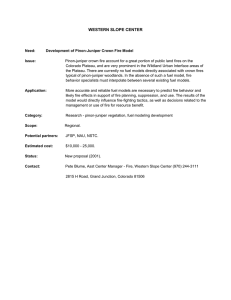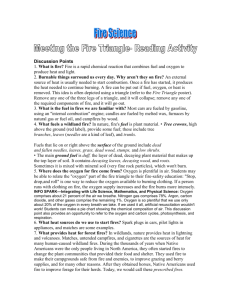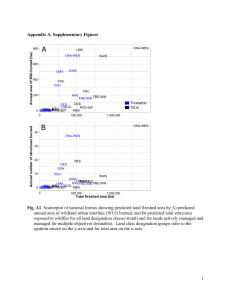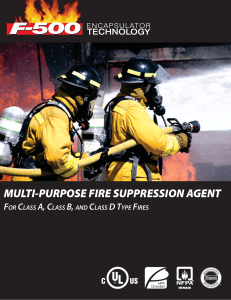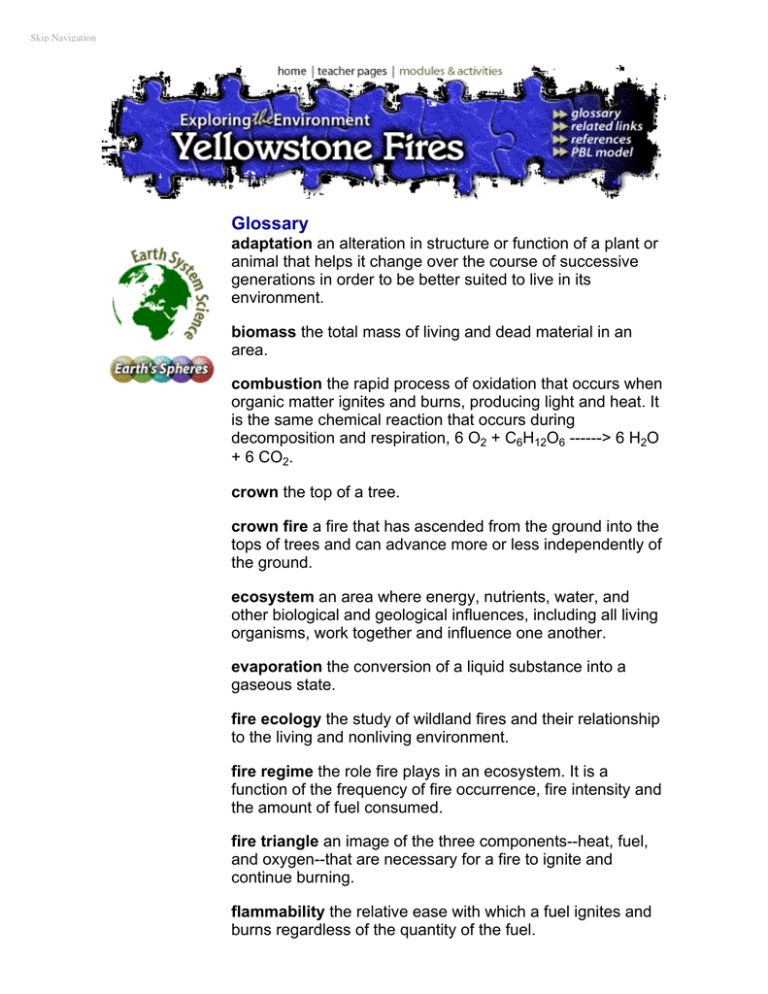
Skip Navigation
Glossary
adaptation an alteration in structure or function of a plant or
animal that helps it change over the course of successive
generations in order to be better suited to live in its
environment.
biomass the total mass of living and dead material in an
area.
combustion the rapid process of oxidation that occurs when
organic matter ignites and burns, producing light and heat. It
is the same chemical reaction that occurs during
decomposition and respiration, 6 O2 + C6H12O6 ------> 6 H2O
+ 6 CO2.
crown the top of a tree.
crown fire a fire that has ascended from the ground into the
tops of trees and can advance more or less independently of
the ground.
ecosystem an area where energy, nutrients, water, and
other biological and geological influences, including all living
organisms, work together and influence one another.
evaporation the conversion of a liquid substance into a
gaseous state.
fire ecology the study of wildland fires and their relationship
to the living and nonliving environment.
fire regime the role fire plays in an ecosystem. It is a
function of the frequency of fire occurrence, fire intensity and
the amount of fuel consumed.
fire triangle an image of the three components--heat, fuel,
and oxygen--that are necessary for a fire to ignite and
continue burning.
flammability the relative ease with which a fuel ignites and
burns regardless of the quantity of the fuel.
fuel all burnable material.
fuel load the amount of potentially combustible material
found in an area. It is usually expressed as tons per acre.
fuel management the treatment of live and dead vegetation
to prevent large-scale, high-intensity wildland fires and to
maintain healthy ecosystems.
geologic processes natural phenomena that operate at the
earth's surface and control the evolution of landscapes and
the resulting quality of the physical environment.
geothermal feature relating to the Earth's internal heat.
Description commonly applied to springs or vents
discharging hot water or steam.
humidity the moisture (water vapor) content of the air. An
increase in air moisture is referred to as an increase in
humidity.
ignition the initiation of combustion.
lightning a discharge of atmospheric electricity
accompanied by a hot flash of light.
nutrient any substance assimilated by living things that
promotes growth.
organic matter carbon-containing plant and animal
residues.
oxidation the loss of one or more electrons by an atom,
molecule, or ion.
photosynthesis the process by which green plants convert
solar energy into chemical energy in the form of organic
(carbon-containing) molecules, releasing oxygen as a byproduct; 6 CO2 + 6 H2O + sunlight ------> C6H12O6 + 6 O2.
plateau a very large, flat area of land that usually is higher
than the land around it. A plateau can sometimes be
surrounded by mountains.
plate tectonics the concept or theory that Earth's crust or
outermost layer is fragmented into a dozen or more large
and small rigid plates that are moving relative to one another
as they ride atop hotter, more mobile material.
prescribed burning human-caused or natural fires that are
allowed to burn because they meet wildland management
objectives without threatening people, property or resource
values.
pyrolysis the second stage of ignition during which energy
causes gas molecules given off by a heated solid fuel to
vibrate and break into pieces.
pyrophytes species of "fire-loving" plants that must be
subjected to fire to complete some part of their life cycle.
remote sensing gathering information about something from
a distance.
respiration the process by which animals oxidize organic
(carbon-containing) molecules to convert their chemical
energy to heat, releasing carbon dioxide and water as byproducts. The chemical reaction for this process is 6 O2 +
C2H12O6 ------> 6 H2O + 6 CO2.
wildfire a highly destructive, uncontrollable fire.
wildland fires all fires that burn in wildlands, including
wildfires and all prescribed fires.
Glossary | Related Links | References | PBL Model
Home | Teacher Pages | Modules & Activities
HTML code by Chris Kreger
Maintained by ETE Team
Last updated April 28, 2005
Some images © 2004 www.clipart.com
Privacy Statement and Copyright © 1997-2004 by Wheeling Jesuit University/NASA-supported Classroom of
the Future. All rights reserved.
Center for Educational Technologies, Circuit Board/Apple graphic logo, and COTF Classroom of the Future logo
are registered trademarks of Wheeling Jesuit University.

